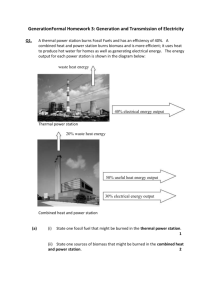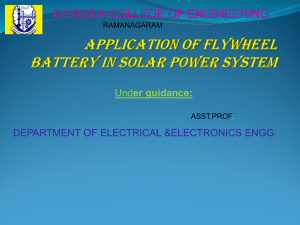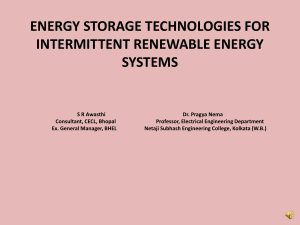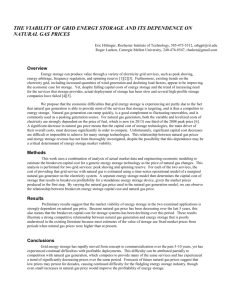Growders Briefing Paper
advertisement
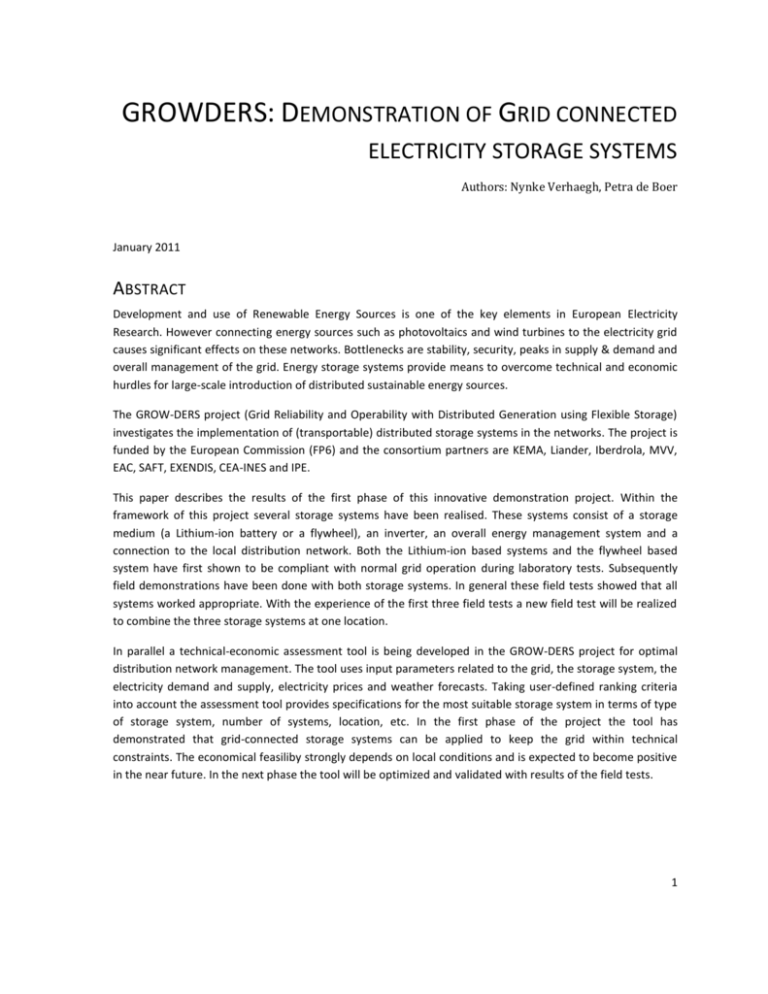
GROWDERS: DEMONSTRATION OF GRID CONNECTED ELECTRICITY STORAGE SYSTEMS Authors: Nynke Verhaegh, Petra de Boer January 2011 ABSTRACT Development and use of Renewable Energy Sources is one of the key elements in European Electricity Research. However connecting energy sources such as photovoltaics and wind turbines to the electricity grid causes significant effects on these networks. Bottlenecks are stability, security, peaks in supply & demand and overall management of the grid. Energy storage systems provide means to overcome technical and economic hurdles for large-scale introduction of distributed sustainable energy sources. The GROW-DERS project (Grid Reliability and Operability with Distributed Generation using Flexible Storage) investigates the implementation of (transportable) distributed storage systems in the networks. The project is funded by the European Commission (FP6) and the consortium partners are KEMA, Liander, Iberdrola, MVV, EAC, SAFT, EXENDIS, CEA-INES and IPE. This paper describes the results of the first phase of this innovative demonstration project. Within the framework of this project several storage systems have been realised. These systems consist of a storage medium (a Lithium-ion battery or a flywheel), an inverter, an overall energy management system and a connection to the local distribution network. Both the Lithium-ion based systems and the flywheel based system have first shown to be compliant with normal grid operation during laboratory tests. Subsequently field demonstrations have been done with both storage systems. In general these field tests showed that all systems worked appropriate. With the experience of the first three field tests a new field test will be realized to combine the three storage systems at one location. In parallel a technical-economic assessment tool is being developed in the GROW-DERS project for optimal distribution network management. The tool uses input parameters related to the grid, the storage system, the electricity demand and supply, electricity prices and weather forecasts. Taking user-defined ranking criteria into account the assessment tool provides specifications for the most suitable storage system in terms of type of storage system, number of systems, location, etc. In the first phase of the project the tool has demonstrated that grid-connected storage systems can be applied to keep the grid within technical constraints. The economical feasiliby strongly depends on local conditions and is expected to become positive in the near future. In the next phase the tool will be optimized and validated with results of the field tests. 1 1. INTRODUCTION The electricity grid has to match energy supply and energy demand, both of which vary randomly in time. On the one hand there are the demand profiles which are characteristic for cultures, climate and season. On the other hand there is the probability of large-scale implementation of intermittent energy sources such as photovoltaics and wind turbines. These sustainable energy sources are intermittent since their electrical energy supply is unpredictable, depending on random factors such as the weather. Energy storage systems can be applied to match energy supply and energy demand. When there is an overcapacity of energy supply the electricity is stored in the storage system; when the demand can not be delivered by the generic network, the storage system can supply this peak demand. Today energy storage systems are not yet common in the electricity network. However technical progress and price reductions make introduction of storage systems possible within the (near) future. The EU-project GROW-DERS is an innovative demonstration project that gains operational experience in grid coupled storage systems. It investigates the technical and economical feasibility of transportable and flexible storage systems in distribution networks. The project is funded by the European Commission (FP6) and the consortium partners are KEMA, Liander, Iberdrola, MVV, EAC, SAFT, EXENDIS, CEA-INES and IPE. Within the project five application areas have been identified for which storage systems can be used: integration of renewable energy sources; trading and generation of electricity; system operators; transmission and distribution network and end-users (industry). Figure 1 shows these application areas. Within the GROWDERS project a technical-economic assessment tool including intelligent prediction software (called PLATOS) has been developed which manages the storage system with respect to these applications. In the field tests a selection of these applications is evaluated. The project focusses on peak shaving / load levelling to prevent overloading, power quality improvements and voltage control. 2 FIGURE 1 SCOPE OF THE GROW-DERS PROJECT. THE FIGURE SHOWS FIVE APPLICATION AREAS FOR STORAGE SYSTEMS IN THE NETWORK (RENEWABLE ENERGY SOURCES; TRANSMISSION AND DISTRIBUTION; TRADING AND GENERATION; SYSTEM OPERATORS; END USER (INDUSTRY) This paper describes results from the first phase of the GROW-DERS project. First, the development of the assessment tool PLATOS is described. This tool monitors and evaluates the storage systems in distribution networks, by assessing whether storage can be applied to keep the grid within technical constraints or to support commercial trade of electricity. Second, the design of a Lithium-ion battery storage system and a flywheel storage system is described. In general batteries provide storage capacity for long term applications, whereas flywheels provide reliable energy storage instantaneous for short durations. These integrated storage systems have been tested and approved under laboratory conditions. At the moment the integrated storage systems are used in field demonstrations. The last paragraph summarizes the results. These results will be used to validate the assessment tool (at the end of 2010). 3 2. ASSESSMENT TOOL PLATOS The assessment tool "PLATOS" has been developed to assess the benefits of various storage systems in generic electricity grids (see Figure 2). Objective of the tool is to select the optimal application of a storage system in a electricity grid. Reference situation • Grid data Optimal storage expressed in: • E-storage specifications system - type of storage system • E-prices - number of systems • Predictions demand and - specifications supply •Evt. weerdata • Optimisation ranking criteria FIGURE 2 SCHEMATIC REPRESENTATION OF ASSESSMENT TOOL PLATOS DEVELOPED WITHIN THE GROW-DERS PROJECT Figure 2 shows that the assessment tool needs input data from: distribution network storage systems demand profiles of houses and supply profiles of sustainable energy sources such as photovoltaics, wind turbines and micro CHPs electricity prices as function of time (per hour, per week, per month, per season) weather forecasts The assessment tool evaluates the input data with respect to the reference situation without storage system. It optimises the storage system based on user-defined ranking criteria. These can be related to costs, overloading, commercial trading and power quality. Finally the assessment tool provides a specification of the most suitable storage system. This specification is expressed in terms of type of storage system, number of systems and location in the grid. 4 In the first phase of the GROW-DERS project the assessment tool has demonstrated that grid-connected storage systems can be technical and economical feasible. This is illustrated by the following three applications, which can be combined: 1. the storage system can be applied to prevent overloads by storing an excess of electricity supply. In combination with a smart energy management system the storage system can be prepared for such supply excesses, which mostly can be predicted in advance. 2. the storage system can support commercial trade of electricity. The user of the assessment tool can set priorities between the stakeholders (operator and trader). This is illustrated in an example in Figure 3. Electricity Price 200 180 Price [€/MWh] 160 140 120 100 80 60 40 20 0 0.00 5.00 10.00 15.00 20.00 25.00 30.00 35.00 40.00 45.00 tim e [h] FIGURE 3 EXAMPLE OF PRICE DEVELOPMENT OF ELECTRICITY AS FUNCTION OF TIME DURING ONE DAY Figure 3 shows that when the electricity price is above € 170/MWh it becomes worth to sell the stored electricity. When the price drops below € 50/MWh it becomes worth to buy electricity to fulfill the electricity demand. In between these set price limits the excess electricity is stored in case of excess supply, and stored electricity is used in case of demand. 3. the storage system can provide power quality improvements such as voltage dips. Figure 4 shows a study case of a storage system integrated in an electricity grid. The voltage is plotted versus cable specification (length, position in the grid). 5 Without storage With storage Upper voltage limit +6 % Voltage 230 V -10 % Under voltage limit Under limit! Transformer Storage FIGURE 4 STUDY CASE OF A STORAGE SYSTEM INTEGRATED IN AN ELECTRICITY GRID (SOURCE: CEA-INES) The assessment tool showed that this storage system prevents the voltage to drop below the under voltage limit. Batteries can combine the value streams nr 1, 2 and 3. With the expected price drops in Li-ion induced by large series manufacturing volumes for EV's and the changing demand and supply profiles, due to more renewables in the system, storage systems may be an attractive option on the longer term for this specific situation. The application of a storage system can defer heavy investments in the network. The assessment tool will be validated by a distribution network specialist during field tests of the integrated storage systems. In addition trainings with the assessment tool are organised to improve the implementation of sustainable energy sources to the distribution network. 6 3. DESIGN OF STORAGE SYSTEMS In this paragraph the energy storage systems are described. Two kinds of storage systems with a magnitude of about 100 kW have been considered. The battery storage systems are based on Lithium-ion batteries (34 kWh) built by SAFT. The flywheel storage system contains a flywheel (0,9 kWh) built by Vycon. In addition the storage systems contain an Energy Storage Inverter (ESI) from EXENDIS and a Control Unit developed by CEAINES to manage the use of the storage system. 3.1 ENERGY STORAGE INVERTER The ESI (Energy Storage Inverter) is developed and supplied by EXENDIS (Figure 5). It is a bi-directional galvanic isolated inverter/battery charger with an input of 230/400 Vac 50 Hz for the mains voltage and 336 to 448 Vdc for the battery voltage. Its power level is 60 kW with water cooling and 30 kW with build in forced air cooling able to drain 90 kW during 10 seconds. The typical efficiency of the ESI is 94.5 %. The ESI can run in parallel with the grid, without the grid, with a generator, and with other ESI’s. The functions originally built into the ESI are: battery charge, inverter (to island grid but also to supply active power) and peak shaving/buffering with generator. During the GROWDERS project following functions are added to the ESI: 1. 2. 3. 4. 5. UPS-mode; in case of grid failure the ESI will take over power seamlessly and automatically Reactive power compensation; stabilizes voltage of long distance grids due to grid inductive and capacitive loads Flicker and Dip compensation; acts to support the grid Harmonic compensation; active harmonic damping Fault ride through capability FIGURE 5 ENERGY STORAGE INVERTER FROM EXENDIS 7 3.2 LITHIUM ION BATTERY SYSTEM The Lithium-ion (Li-ion) battery is supplied by SAFT (see Figure 6). FIGURE 6 LI-ION BATTERY CABINETS FROM SAFT The Li-ion battery offers 34 kWh of energy in a voltage window from 336 to 448 Vdc. The battery is able to be charged at 8.5 kW (20 A) in less than 5 hours and to be discharged continuously at 40 kW (100 A) or at 75 kW for a short duration. The battery is made of sixteen 24 V cell modules and two battery management modules (BMM) dispatched in two cabinets. Each cell module contains fourteen VL45E Li-ion cells stacks in two strings of seven cells in series (2p7S) (Figure 7). The BMM contains a circuit breaker, a contactor, a man machine interface and a battery management controller for operational and safety functions. The communication between the module and outside the battery works by CAN-BUS. 8 FIGURE 7 LI-ION BATTERY CELL MODULES FROM SAFT 3.3 FLYWHEEL SYSTEM The flywheel consists of a rotor suspended by bearings inside a vacuum chamber to reduce friction (see Figure 8). During charge the flywheel is connected to an electric motor: it stores electricity in the form of rotational energy. During discharge the flywheel is connected to a generator: it supplies electricity by reducing the speed of the rotor. A flywheel is typically designed for short discharge applications. FIGURE 8 SCHEMATIC REPRESENTATION OF THE VYCON FLYWHEEL SYSTEM 9 The flywheel used in the GROW-DERS project is developed and supplied by Vycon (see Figure 9). The power level of the flywheel is 200 kW, but in this specific system it is limited to 90 kW based on the specifications of the ESI. The flywheel offers only 0.9kWh. It is charged at 25 A based on thermal limitations of the flywheel and it is discharged at 40 kW (100 A) to prevent overloading of the transformer. FIGURE 9 FLYWHEEL SET UP FROM VYCON. THE CABINET CONTAINS A FLYWHEEL IN THE MIDDLE AND A VACUUM POMP UNDERNEATH. 3.4 COMMUNICATION WITHIN STORAGE SYSTEM The communication between the ESI and the battery and/or the flywheel is done via MODBUS. The communication between the system and the system management is done via GPRS (General Packet Radio Service) (see Figure 10) 10 FIGURE 10 SCHEMATIC REPRESENTATION OF THE COMMUNICATION SCHEME BETWEEN THE BATTERY (OR FLYWHEEL) THE INVERTER AND THE SYSTEM MANAGEMENT 3.5 CONTROL UNIT The management of the storage system is performed by the Control Unit or Energy Management System. Three levels can be distinguished. 1. The first level consists of planning. Based on predictions (for example weather forecasts) and the spot electricity price of the next day the use of storage is planned one day in advance. Set points are defined to charge or discharge at the best times. 2. The second level consists of real-time management of the storage system. It defines the instructions to be sent to the inverter. These concern the active and reactive power to be supplied or stored by the storage system and adjusts the set points according to the grid status. 3. The third level consists of the real time control of the components: ESI, battery and/or flywheel. This control level is mainly concerned with security features (operations outside normal range). The spot electricity price of the next day (in our application it is simulated) and set points are defined to store/inject at the best times; the second level adjusts the set points according to the grid status. 11 4. RESULTS OF THE LABORATORY TESTS OF STORAGE SYSTEMS All storage systems have been tested under laboratory conditions. Figure 11 shows a test setup of a battery storage system at the INES/CEA laboratory in Chambery, France. FIGURE 11 TEST SETUP OF A BATTERY STORAGE SYSTEM AT THE INES LABORATORY IN CHAMBERY, FRANCE. Figure 12 shows a test setup of a flywheel storage system tested by Liander in Apeldoorn, the Netherlands. FIGURE 12 TEST SETUP OF A FLYWHEEL STORAGE SYSTEM TESTED BY LIANDER IN APELDOORN, THE NETHERLANDS. 12 The objectives of the laboratory tests were to validate the storage systems and to check good operation before field tests. Therefore several tests have been performed: Communication between components Measurement of real storage capacity Active and reactive power tests AC voltage variation tests Islanding monitoring tests Experiments and prolonged field test have been monitored online. Data involved various network loads, voltages and currents, but also relevant external conditions, like solar radiation and wind speed, influencing local loads. Both the battery and flywheel storage systems passed the above mentioned tests successfully. Notably, the flywheel system has been tested under more extreme conditions than the battery system. The experiments confirmed that a flywheel based system is more appropriate for instantaneous power supply on a timescale of only minutes, whereas a battery based system is more appropriate for energy supply on a time scale of hours. The combination of a flywheel and a battery increases the lifetime of the integrated storage system significantly. The laboratory tests showed that the communication between the different components within the system turned out to be the most critical factor. 5. FIELD TESTS Table 1 shows an overview of the field tests of two Li-ion based storage systems, one flywheel based storage system and one combined battery and flywheel storage system. TABLE 1 location storage system energy rating power rating OVERVIEW OF FIELD TESTS OF INTEGRATED STORAGE SYSTEMS IN THE GROW-DERS PROJECT Chambery demonstration sites Zamudio Zutphen Li-ion Li-ion flywheel [kWh] 40 40 0,9 [kW] 0 - 50 0 - 10 0 - 90 Mannheim Li-ion + flywheel 40 + 0,9 0-10, 0-50, 0-160 Demonstration tests of battery storage systems have been done at the Iberdrola facilities in Zamudio, Spain and at INES/CEA facilities in Chambery, France. Demonstration tests of the flywheel storage system have been performed at Liander facilities in Zutphen, the Netherlands (see Figure 13). Later on (starting in January 2011) an integrated storage system consisting of a Li-ion battery and a flywheel will be tested at MVV facilities in Mannheim, Germany. 13 a b FIGURE 13 TEST LOCATION OF FLYWHEEL IN ZUTPHEN, THE NETHERLANDS. A) MAP OF PARK BRONSBERGEN: RED ARROW INDICATES TEST SITE OF LIANDER. B) TEST HOUSE OF LIANDER INCLUDING SOLAR PANNELS, BATTERIES AND FLYWHEEL 5.1 FIELD TEST IN SPAIN The location In Spain a battery storage system is connected to the grid in the area of the technology park of LABEIN Tecnalia. LABEIN Tecnalia is a privately-owned technology centre. This technology park is a business park with several buildings with mainly offices and some research facilities. The distribution grid is part of the Iberdrola network in Spain. Due to the end users in this grid the electricity demand is high during the working hours and low during night and weekends. As this is a technology parc there are some renewable energy sources connected to the grid. 14 FIGURE 14 TEST LOCATION OF BATTERY SYSTEM IN ZAMUDIO, SPAIN The tests At this location first several laboratory tests were done using a grid simulator. After this period of extensive testing a period of one month was used for continous running of the whole system during the Month June 2010. FIGURE 15 TESTED BATTERY SYSTEM IN ZAMUDIO, SPAIN 15 Main results of the field test The transportation and installation of the whole system was relatively easy to do. It was clear how to install the system and how to use it (all equipment and the manual were sufficient). After some start-up problems the whole system was working well. The anti-islanding mode of the ESI works very well, this is very positive, but also meant that in this set up it was not possible to do all tests. Some of the tests (like tests with voltage dips) needed circumstances that were not allowed by the islanding mode. The anti islanding protection software is therefore updated. The used grid simulator didn't work well enough to test for voltage dips. Therefore this test location was not that good as expected in the beginning of the project. So even with an ESI without the anti-islanding mode it was not possible to test the system for voltage dips in this set up. So in practice the battery was mainly used to compensate for flicker and not for voltage dips. Besides the system was used for peak shaving to prevent possible overloading. The system for harmonic compensation worked, but not exactly as expected. A good setpoint selection is therefore a critical step in the implementation phase of a storage system. 5.2 FIELD TEST IN THE NETHERLANDS The location In The Netherlands a flywheel storage system is connected to the grid in the area of a holiday parc in Zutphen (Bronsbergen). At this park you can find about 200 holiday houses. About 50% of the houses has solar panels on the roof of the houses for a total of 300kW. One of the houses in this area is owned by Alliander, the grid operator in this area. Alliander has installed the flywheel and used it for several months. Due to the type of location the grid has a specific load profile. There is a relatively large volume of renewable (solar) energy, while the end users are using holiday houses, which gives the profile another profile than normally in houses or communities and the harmonics flicker and all other induced by the 200 solar inverters. FIGURE 16 TEST LOCATION OF BATTERY SYSTEM IN HOLIDAY PARC BRONSBERGEN, ZUTPHEN, THE NETHERLANDS 16 The tests First laboratory tests were done in the USA and in Apeldoorn (The Netherlands) to test the flywheel under extreme conditions and in combination with micro-CHP . Afterwards the flywheel was connected to the grid in Zutphen to test and operate it under real life conditions. FIGURE 17 TESTED FLYWHEEL IN ZUTPHEN, THE NETHERLANDS Main results The transportation and installation of the whole system was relatively easy to do. It was clear how to install the system and how to use it (all equipment and the manual were sufficient). After some start-up problems the whole system was working extremely well. Especially for the remote control some extra facilities were installed to be able to use the management software remotely. In grid connected mode and island operation the system worked perfectly. The compensation for harmonics worked perfectly and also the voltage dip contribution. Optimisation of the setpoint settings was done to optimize the results. 17 For reactive power the system was OK. Jumping from grid connected to island operation did work perfectly (connected to loads < 30kW) Furthermore the installation did work perfectly for testing other equipment in island operation , making frequency jumps from 1 to 20Hz up and down Negative points were the power loss and the noise caused by the constant running vacuum pump and cooling fans ( by the lack of a temperature control) 5.3 FIELD TEST IN FRANCE In France a laboratory test setup is available to test the batteries in a test grid of INES. First all battery systems were tested in this laboratory test setup. This was done to check the systems under extreme conditions and also be sure that all systems were ready to be used in a real grid. Not only the performance of the components was tested, but also the combination of the components was checked, for instance the communication between the components. One of the battery systems was used in this same setup for a longer test run as a real field test. Objective of this field test is to check the updated version of the energy management system and to optimize this system before it can be used in the final field test in Mannheim. Tests that were not possible in Spain, were done in this test set up in Chambery in France. All results were used to optimize the management of the storage systems. 5.4 FIELD TEST IN GERMANY In Germany a final field test will be realized in Mannheim. In this field test the 3 storage systems will be combined at one location. At this location a large PV system will be added to the distribution grid. Storage systems might help for both PQ control and load alleviation. By bringing all storage systems together at one location, the transportability of the systems will be demonstrated. Moreover the value of combinations of several storage systems will be demonstrated. Finally these results will be used to validate the assessment tool. This field test in Mannheim is scheduled for the first 6 months in 2011. 18 CONCLUSIONS In 2009 integrated storage systems connected to the local distribution grid have been tested under laboratory conditions within the frame of the GROW-DERS project. Two Li-ion battery systems have been tested at INES/CEA in France and a flywheel system has been tested by Liander in The Netherlands. The tests demonstrated the compliance of both the Li-ion battery systems and the flywheel system with the specifications for good operation in grid-connected mode. After these first validations field demonstrations have done with battery systems in Zamudio, Spain and at INES/CEA facilities in Chambery, France (in 2009 – 2010). Field demonstration of the flywheel system has been performed at Liander facilities in Zutphen, The Netherlands. In general these field tests showed that all systems worked appropriate. With the experiences of these three field tests a new field test will be realized in Mannheim, to combine the three storage systems at one location (January 2011– June 2011). In parallel an assessment tool has been developed which has demonstrated that grid-connected storage systems are technical feasible and will probably become economical feasible in the near future. Based on input date such as information of the grid, the storage system, electricity demand and supply and weather forecasts, the assessment tool can be applied to recommend the most suitable storage system in terms of type of storage system, number and location in the grid. The assessment tool works with user-defined ranking criteria related to overloads, commercial trading and power quality. The criterium to maximize profit by commercial trading next to the technical objectives to prevent overloading, makes storage systems economically very interesting. 19

